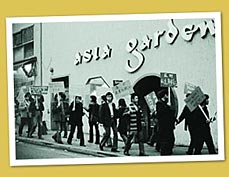|
|
|
|
|
||||
|
|
|
|
|
|
|
|
 |
Busboy strike at San Francisco Chinatown restaurant in 1974 over working conditions and tips. In the '70s, many disputes flared up in Chinatown over wages and working conditions. Activists joined picket lines; workers sought out activists for support and advice. These new links opened up new ways of seeing how community forces could unite, leading people like Gordon Lee to wonder about "what we are and what we can be" (see text below). |
Parting the Wild Horse's Mane: Asian American Images an the Asian Media Collective[excerpt]
(a One-Act Readable Play) Images could be very powerful. The first time I heard Chris and Joanne [one of the first Asian American folk groups] sing, something opened inside me. I had never thought of myself that way -- a grain of sand, in the belly of a monster, a yellow pearl -- descended from a line of courageous workers who built railroads, endured great hardships, faced exclusion acts, were not allowed to own property or to marry outside our race -- raised by women who slaved in sweatshops. It's hard to explain why it affects me so deeply, but it is like "seeing" for the first time. Seeing that we didn't have to fit into someone else's world, into someone else's image. Learning about our own history, our own culture, one that had been hidden for a long time. It is -- like finding a piece of myself. I learn how to write my Chinese name. I begin looking for my own stories. That's what this [Asian Media Collective] stuff is all about. And it affects all of us. We can't go back to being, to fitting those old images anymore. Rather, can we find those images that will reflect, will show us what we are and what we can be? |
||||||
